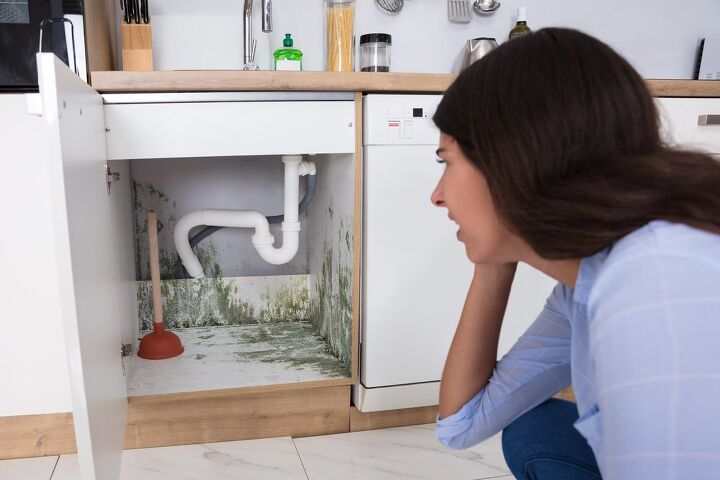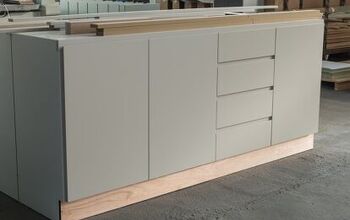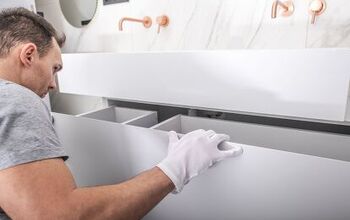What Causes Mold In Kitchen Cabinets? (Find Out Now!)

Mold can be a problem in kitchens, and it often appears in locations we least expect. One of these places is the cabinets. If you have noticed mold in your kitchen cabinets, you might wonder what causes this growth. What leads to mold in this secluded location?
Mold in kitchen cabinets can be caused by humidity, rotting food, and lack of ventilation. A wet cabinet can also lead to mold by trapping air inside the space. Knowing where mold comes from inside kitchen cabinets will prepare you to prevent this damage from occurring in the future as you continue to cook.
Read on to learn more about each of the factors that might lead to mold in your kitchen cabinets. Once you have a better understanding of what causes mold, you can act to ensure it stays away. Mold is something no one wants inside the place where they cook.
Do You Need Mold Inspectors and Testing Services?
Get free, zero-commitment quotes from pro contractors near you.

Cause of Mold Inside Kitchen Cabinets
Many things take place in a kitchen, and many items can lead to molding inside kitchen cabinets. As you probably already know, mold can be harmful. Mold can be dangerous to the elderly and those that struggle with breathing issues. Mold inside a shared space can be deadly if not taken care of right when it appears.
As stated above, the most common causes of mold in a kitchen cabinet include:
- Humidity
- Rot inside food
- Poor ventilation
- Wetness from a leak
These lead to the growth of mold.
Read on to learn more about each of these causes. By understanding what leads to mold, you can prevent it from happening and stop the growth in its tracks.
Humidity
Humidity is one of the top causes of mold inside a kitchen cabinet. The thick air creates an environment that fosters the growth of this organism, allowing it to expand and spread all over your kitchen cabinet. Unfortunately, humidity is a common occurrence in kitchens used often.
Some of the top causes of humidity in a kitchen come from:
- Using a dishwasher
- Cooking on a stove
- Living in an area with natural humidity and leaving windows open
These are all reasons humidity might occur in a kitchen, though anything that uses liquid in an evaporated format can lead to excess moisture in the air.
When humidity builds up inside an enclosed space, mold will eventually follow if the liquid in the air is not dealt with accordingly. Check for this issue first if you are experiencing this growth inside your cabinets. Many are not aware of the damages humidity can cause.
Rotting Food
Rotting food is another reason you might have mold inside your cabinets. Rather than starting in the wood, mold, this way occurs from the food as a source. There are certain foods susceptible to molding that cannot stay inside a cabinet for very long.
Some examples of foods that are prone to mold easily include:
- Fruits, such as apples and raspberries
- Vegetables, such as carrots and squash
- Bread, including bagels and sandwich bread
- Cheese, such as swiss and cheddar
These foods grow mold fast and need to be refrigerated at some point in their life cycle.
If you store perishable foods in your cabinet, there is a high chance they are the source of mold. Ensuring you refrigerate your foods properly and clean out your cabinet regularly will rid this space of mold that starts to grow. Stay on top of your groceries and update them as is necessary.
Poor Ventilation
Restricted air circulation works with humidity to place moisture inside the cabinet and create an atmosphere for mold to thrive. If the liquid in the air has a place to escape, you can prevent it from growing. If your cabinets sit in a way where the humid air becomes trapped, mold has the opportunity to thrive.
Some ways you can create ventilation in a cabinet include:
- Leaving the cabinet open while you cook, allowing humid air to filter out of the space
- Opening a window if the air outside is not filled with moisture, particularly if it is cool outside
- Fanning out the room before sealing everything up and letting it sit
These actions can help to provide ventilation in a room, preventing a mold-positive environment from thriving.
Any air that sits in an enclosed space in a kitchen is a recipe for disaster. Many kitchens lack poor ventilation, which leads to molding processes inside of wooden kitchen cabinets. Preventative actions can stop the mold from growing at all, killing it at the source right away.
Contact with Liquid
Finally, any liquid that sits inside a wooden cabinet can lead to molding. There are many ways that water can come into contact with a cabinet in your kitchen. It is critical to find and address these sources before mold can take root and grow in the space where you cook your food.
Some of the causes of liquid inside a kitchen cabinet include:
- Problems with a water supply line/refrigerator water line
- Dishwasher flooding that extends to the cabinets
- Ruptured pipes
- Congested sinks
These are a few reasons why your kitchen cabinets might become soaked, though any leak can cause an impact on the dryness of this storage space.
If you notice mold along with a soaked kitchen cabinet, check for one of the mentioned issues. You should clean out the mold and fix the leak as soon as possible. This action will stop the growth of more mold in the future. It should be easy to find where the water is coming from if the leak is significant enough.
Do You Need Mold Inspectors and Testing Services?
Get free, zero-commitment quotes from pro contractors near you.

Related Questions
How do I get rid of mold inside my cabinet?
The best way to get rid of mold is to use a mixture of half detergent and half water. Applying this and scrubbing with a brush will get rid of the growth in no time.
What does mold look like inside a cabinet?
Mold inside a cabinet will often look fuzzy. It is most often black, grey, or green. However, it can also be brown, purple, pink, white, or red. The indicator you should look for is the fuzzy texture.
How do I get the dampness out of my cabinet?
To remove dampness from a cabinet, check for leaks and declutter the shelves. This act should prevent more wetness from occurring.

Hannah DeMoss has been a writer for nearly a decade. Her passion for writing began years ago has continued to grow. Her expertise at home involves furniture restoration and other small DIY tasks. When not writing, Hannah enjoys the outdoors with her husband and pups, as well as traveling.
More by Hannah DeMoss























![10 Most Dangerous Neighborhoods in Baltimore [Updated]](https://cdn-fastly.upgradedhome.com/media/2023/07/31/9075655/10-most-dangerous-neighborhoods-in-baltimore-updated.jpg?size=350x220)


![12 Washing Machine Brands to Avoid [with Recall Data]](https://cdn-fastly.upgradedhome.com/media/2023/07/31/9075781/12-washing-machine-brands-to-avoid-with-recall-data.jpg?size=350x220)
